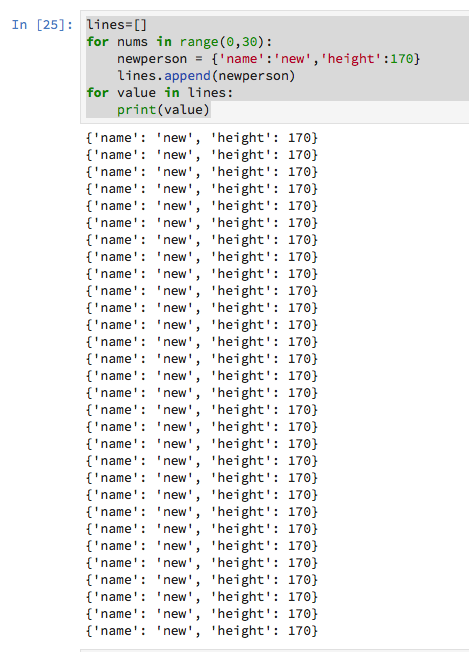Python 字典
每种语言都有它对文件和数据库的处理方式,python也一样,而且python的数据操作中的字典特别好用,而且用法简单。下面,让我门一起学习python的字典:
1.字典的创建:
person={'name':'xiaoming','height':75,hobby:'ping pang ball' }
注意事项:(1).用花括号
(2).键和键值之间用“ :”来标注
2.字典的使用:
print(person[name])
the result is 'xiaoming'
3.动态添加键,值:
person['tel'] = "18132091111"
print(person['tel'])
4.删除键:
del person['tel']
这样我们就删除了person的tel键
5.修改键值:
person['name'] = 'xiaowang'
可以看出,我们只需重新为键赋值就行了,非常方便
6.遍历字典:
(1.)遍历键和对应的键值:
for key, value in person:
print("the key name is" + key)
print("the data of the key is" + value)
(2).遍历键:
for key in person.keys():
print(key)
(3).遍历键值:
for value in person.values():
print(value)
可以看出,如果我们只想遍历键时我们可以用keys()方法,如果我们只想遍历键值时我们可以调用values()方法。但是需要注意的是,遍历时并不一定是按照顺序次序输出的。如果我们需要按照一定的顺序输出,可以用到sorted()函数
eg:
for value in sorted(person.keys())
7.字典列表:
(1).列表中储存字典:
静态储存:
person1 = {'name':'xiaoming,'height':170}
person2 = {'name':'xiaowang','height':175}
lines = [person1,person2]
for data in lines:
print(data)
动态储存:
lines=[]
for nums in range(0,30):
newperson = {'name':'new','height':170}
lines.append(newperson)
for value in lines:
print(value)
(2).在字典中储存链表:
lines=[]
for nums in range(0,5):
newperson = {'hobby':['games','pingpangball','music'],
'grade':'one'
}
lines.append(newperson)
for value in lines:
print(value)
想想,其实也挺简单的,没什么啊,对吧?
(3).在字典中储存字典:
person = {
'man':{'sex':'boy','height':175,'info':'strong'},
'woman':{'sex':'girl','height':160,'info':'beautiful'}
}
print(person)


